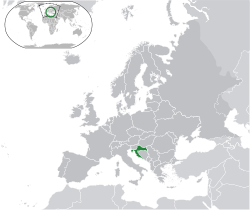Talk:Croatian Identity
Work page
- "Pope Gregory's ad 600 letter to the bishop of Salona to commiserate about raids, Salona" (raids by Slavic tribes) taken from: Croatia By James Stewart (p9)
- "BRANIMIRO COMITE DUX CRUATORUM COGITAVIT" (c. 880 AD) taken from A history of the Croatian language: toward a common standard by Milan Mogus
This is interesting: www.hic.hr: Latin as a literary language among the Croats (up till 1848), Vecernji.hr: Preživjeli ledeno doba: Hrvati su prastanovnici Europe (Vecernji.hr: Surviving an ice age: the Croats are descendants of prehistoric Europe)
- More than three quarters of today's Croatian men are the descendants of Europeans who inhabited Europe 13000-20000 years ago. They survived the last ice age within certain regions on Europe.
The Early Beginnings of Formal Education - Vela Luka (beginnings of literacy and Lower Primary School 1857 – 1870): "Talijanski je jezik bio ne samo službeni jezik u svim dalmatinskim javnim usta-novama, već pretežito i govorni jezik u znatnom broju činovničkih, službeničkih i tr-govačkih obitelji u gradovima i većim trgovištima." (Italian language was not only the official language in all public Dalmatian establishments, but also was the spoken language in a significant number of white-collar, civil service and merchant families in the cities and major markets within towns)
Note to self: Imaginary history (written text, assortment of paintings)
Note to self: There is a major difference between...
- raids
- settlement
- mass migrations
Note to self:
- Roman Latin-Illyrian population (Croatian men are the descendants of Europeans who inhabited Europe 13 000-20 000 years ago.) plus Celts, Liburnians,Greeks
- The Ostrogoths (a Germanic tribe related to the Goths)
- Slavs (intermixed with Sarmatians)
- Within the Kingdom of Croatian (925–1102AD) all of her citizens weren't ethnic Croatian Slavs.
Note to self:
- Baska tablet (1100 AD)
| “ | AZ V' IME OTCA I S(I)NA I SVETAGO DUHA AZ'
OPAT' DR'ŽIHA PISAH SE O LEDINE JuŽE DA Z'V'NIM(I)R KRAL' HR'VAT'SKI V' DNI SVOE V' SVETUJu LUCIJu I SVEDO - MI ŽUPAN' DESIMIRA KR'BAVE MARTIN' V L(I) - CE PRB'NEBŽA S' POSL' VIN(0)DOLE JaK(O)V' V O- TOCE DA IŽE TO POREČE KL'NI I BO(G) I *BÏ* AP(OSTO)LA I *G* E - VANJELISTI I S(VE)TAJa LUCIJa AM(E)N' DA IŽE SDE ŽIVE - T' MOLI ZA NE BOGA AZ OPAT' DBROVIT' Z' - DAH' CREK'V' SIJu I SVOEJu BRATIJu S DEV - ETIJu V' DNI K'NEZA KOS'M'TA OBLAD - AJuĆAGO V'SU K'RAINU I BJeŠE V' T' DNI M - IKULA V' OTOČ'CI S' SVETUJu LUCIJu V' EDINO |
” |
http://www.croatianhistory.net/glagoljica/baska.mp3
Old Croatian (Chakavian with elements of liturgical Church Slavonic), translated in 1875: "I, in the name of Father and Son and the Holy Spirit, I abbot Drzhiha, wrote this about the plot of land which was given by Zvonimir, the Croatian King, in his days to St. Lucy and witnesses [are]: Desimir, Prefect of Krbava, Martin in Lika, Pribinezha, clerk in Vinodol, Jacob on the island. If anyone denies it, let him be cursed by 12 Apostles and 4 evangelists and St. Lucy. Let anyone who lives here prays God for them. I abbot Dobrovit built this church with my nine brethren at the time of Prince Kosmat who ruled the whole Country. In those days Mikula was in Otochac with St. Lucy together."
- Valun tablet (11th century)
- Plomin tablet
Danijel Dzino: "In addition, pope Gregory the Great mentioned the 'Slav' raid of Istria in a worried letter to Maximus the" this is regarding Slavic raids north of Dalmatia in 600AD. May be the first mention of Slavs arriving in Roman Dalmatian but as Danijel Dzino states it does not have to mean "mass migrations". Becoming Slav, Becoming Croat: Identity Transformations in ... Page 88
John Van Antwerp Fine: "In 879, under him, Dalmatian Croatia, now free of Frankish suzerainty, received papal recognition as a state. ... 864), ruled until about 910, when he was apparently succeeded by Tomislav, probably his son." The early medieval Balkans by John Van Antwerp Fine Page 260
Translation
(Croatian)
Jedan od prvih primarni izvor spomenuti hrvatsko-Hrvat identitet na Balkanu je Dux Cruatorum Branimero ili kneza Branimira (latinski: dux Croatorum). On se pojavio na kameni natpis, c. 880 AD. Kneza Branimira je Slaven iz Dalmacija. Hrvat ili Horoúathos su imena od Sarmat podrijetla. U 1853 Ruski arheolog Pavel Mihajlovič Leontjev otkrio Tanaisa tablete. Tablete Tanaisa spominju tri čovjeka: Horoúathos, Horoathos i Horoathos (Χορούαθ [ος], Χοροάθος, Χορόαθος). Oni su pisani na grčkom i u 3. stoljeća iz grada Tanaisa, današnjeg Azov, Rusiji. U to vrijeme regija je imala mješoviti Grčki - sarmat (iranski) populacije. Termin slavenski prvi su upotrijebili Bizant (tj. Prokop-bizantski učenjak, Jordanes-6. stoljeća rimski birokrata), i bio zabilježen je u 6. st. (cia. 550) na grčki (Σκλαβῖνοι-Sklabenoi). Kasnije na latinskom je pisana Sclaveni.
- Since your here have a listen to Australia's Lisa Gerrard - Now we are free
|
|
